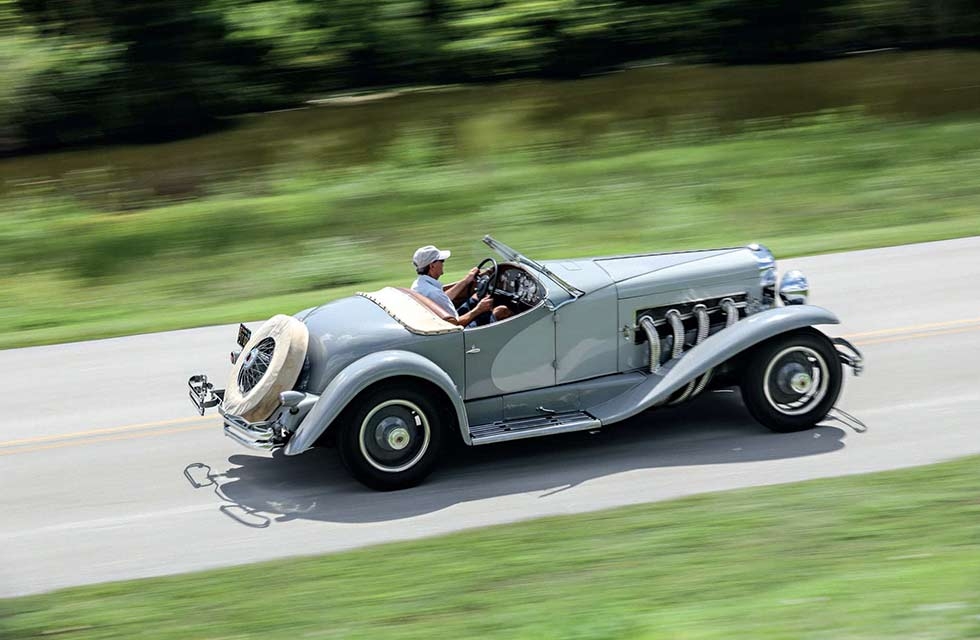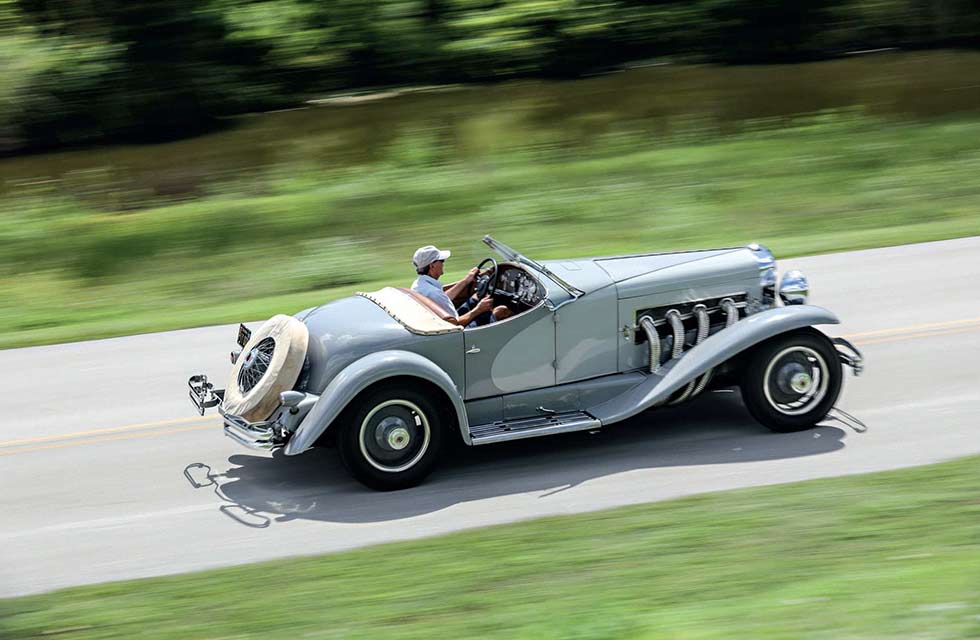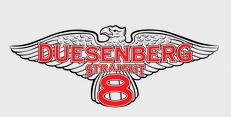
Cooper’s Duesie Just two short-chassis Duesenberg SSJs were built for Hollywood stars, and they became America’s most prized sports cars. Words Mick Walsh. Photography Mathieu Heurtault/ Randy Ema/La Public Library.
A MOVIE-STAR’S MUSE: THE $22M DUESIE SSJ Mick Walsh tells the story of a stunning pre-war supercar built for a movie star
Back in 1985, on my first trip to America, I was determined to see two fabled machines that had captivated me since boyhood. Amazingly, both were in Los Angeles museums just 30 miles apart. These mighty mechanical marvels were the Spruce Goose, Howard Hughes’ giant H-4 transport seaplane, and the ex-Gary Cooper Duesenberg SSJ, the most powerful pre-war sports car ever built. Both exceeded my high expectations. The short-chassis ‘Duesie’, one of just a pair built for two of America’s then-greatest movie stars, had enthralled me since discovering a photo within Treasury of the Automobile by Ralph Stein in the local library. The stories of its 130mph performance and spectacular 320bhp from its magnificent, green-painted straight-eight twin-cam motor with central supercharger that ran at six times engine speed were as fantastic as any Marvel comic.

Finally walking into owner Briggs Cunningham’s famous museum in Costa Mesa will never be forgotten. There it stood, resplendent in its two-tone grey paint next to a Mercer and facing a brutish line of Cunningham team cars. Even without hearing the Wagnerian roar of its 6.8-litre ‘eight’, the SSJ took my breath away. For an American marque, Duesenberg had enviable pedigree, winning the 1921 French Grand Prix and taking triple Indy 500 victories that decade, too. The SJ made its debut in 1928 but just 36 were built, mostly with heavy, glamorous bodywork by America’s finest coachbuilders.
In lightened, streamlined form its performance was legendary, as confirmed by Ab Jenkins’ astonishing 135mph average for 24 hours, a speed record on the Bonneville salt flats that only the Napier-Railton eclipsed. The short-chassis SSJ was the ultimate factory hot rod, built in desperation to boost flagging sales through the expected publicity of movie-star connections. The first was loaned to Gary Cooper, a childhood hero who starred in my dad’s favourite western, High Noon. The car’s amazing story had everything. Listening to curator John Burgess’ stories, it was easy to imagine the fantastic episodes of its colourful life, be it roaring across LA at night en route to a Hollywood party, storming around Lake Tahoe with a valiant hydroplane-racing ace at the wheel, or blasting across a dry lake with a trail of dust in its 130mph wake. This was, without a doubt, America’s first supercar.
Friends have argued the Duesenberg Model J was all hyperbole with very optimistic power figures, excess weight and, by the mid-’30s, an outdated design that had little-changed since its 1928 launch. The shorter SSJ’s proportions, they claimed, were unbalanced: too high, with out-of-proportion small wheels. But I adore its imposing stance with steeply raked ’screen and low, short cockpit that’s almost lost behind that long, tall bonnet. Stylist Jesse Herbert Newport Jnr originally planned a more streamlined body, but the second attempt was classic Duesenberg. The two SSJs were completed in late 1935 and marque saviour Errett Lobban Cord instructed his son Charles to deliver the cars personally to Clark Gable and Cooper. Cord was then working as a salesman at the firm’s main Los Angeles showroom on Wilshire Boulevard and, considering the prestige of the two movie stars taking ownership, it’s perhaps surprising that no photos survive showing the presentation of the fastest cars in America to Cooper or Gable.
Story has it that chassis 2594 (engine number J-563) was originally painted a sandy yellow. After delivery to the Paramount film set on 15 December, Cooper reportedly drove the car home to Bedford Drive, Beverly Hills, but his enthusiasm for the exotic two-seater wasn’t shared by his young wife Veronica ‘Rocky’ Balfe, who particularly didn’t like the colour. The car was sent back to the dealership with a request to repaint it ‘in dark green with silver trimmings’.
Cooper’s career was on a roll in 1935, with his adventure The Lives of a Bengal Lancer receiving six Academy Award nominations. Director Henry Hathaway rated his lead the “best actor of them all”, and Frank Capra had held up filming of Mr Deeds Goes to Town to secure the 35-yearold star. Cooper looked the ideal Duesenberg owner and could have modelled for artist Paul Gerding’s ‘He Drives’ advertisements.
The loan of the SSJs was limited to six months, after which both stars were offered a special deal on the cars at $5000, a third of the usual price. Gable turned it down, but Cooper, who loved driving his SSJ, accepted. Against the already discounted price, he traded in his Model J-431 Derham Tourster, which he’d ordered directly from the stand at the 1931 Chicago show.
Both SSJs were bodied at the factory’s in-house Union City Body Works in a style known as LaGrande, to underline their exclusivity. The styling was near identical but the second SSJ – J-567 – featured a ‘Duesenbird’ radiator mascot and a more acute sweep to the rear wing.
Nothing is recorded about Cooper’s experiences with the SSJ, but both short-chassis Duesies remained in LA. During the late ’30s they were spotted together on a famous car lot of dealer Bob Roberts, just a block down from Hollywood Boulevard. Roberts had no trouble selling the ex-Cooper car after the wealthy young enthusiast Reese ‘Bud’ Milner spotted the SSJs in the showroom. Born to a prominent LA family, Milner had returned from Stanford University to run the family oil business and had just married glamorous dancing starlet Ann Miller – the couple must have made quite an entrance arriving at LA parties in the SSJ.
Milner moved in wealthy social circles and quickly sold the Duesie to former Stanford buddy Robert Stanley Dollar Jnr. The heir to a timber business, the Dollar Steamship Line, and the Wychwood estate on Lake Tahoe, Dollar’s obsession from an early age was speed on water. After international racing success in America and Europe during the 1930s, he served in the Philippines during the war. Come peacetime, Dollar, aided by his loyal riding mechanic Ollie Meek, built the spectacular Skip-A-Long of California. Powered by a 2000hp Allison V12, it dominated the 1949 season at heady speeds before sinking on Lake Tahoe. Compared to the wild ride of his racing hydroplane, the leaf-sprung SSJ must have felt super-smooth as Dollar opened up the supercharged straight-eight on roads around scenic Tahoe.
Through the 1940s, the ex-Cooper Duesie changed hands a few times but remained on the West Coast until acquired by D Cameron Peck of Illinois, a car collector who already owned the Gable SSJ. Peck had no intention of keeping both cars and quickly sold J-563 in 1949 to his friend Briggs Swift Cunningham, the dashing playboy sportsman who famously raced both cars and yachts at a premier level.
Cunningham had immaculate taste and the foresight to save many important historic cars, which he stored in stables around his huge Connecticut estate. From Grand Prix Delage to thoroughbred Alfa 8C, the focus of the growing collection was European, but the newly acquired Duesenberg fitted perfectly into the elite group. He enjoyed driving his cars and enlisted the best specialists to restore and tune them.
In spring 1949 he contacted Jim Hoe, better known as ‘The Duesenberg Man’, about his exciting new purchase, and instructed the specialist to fly out to Chicago to visit Peck and pilot the SSJ back to Connecticut; Hoe had no hesitations about driving the then 14-year-old Duesenberg on that 850-mile journey. No photographs were taken, but I love the idea of the supercharged roadster roaring along in the early summer, maybe stopping at a motel in Cuyahoga Valley National Park as he travelled east. ‘I had a wonderful time,’ recalled Hoe in the ACD Bulletin. ‘It was a delightful car to drive, a winner all the way, but after a complete check-over, retiming the valves and other adjustments, it went like a bomb.’
Cunningham immediately repainted J-563 in a two-tone scheme with olive over a dark blue sweep panel including the radiator shell, and smaller, more modern lights were fitted. Appropriately registered ‘DUSY’, the great car was much enjoyed by Cunningham around New England, and maybe he even took it down to the Pequot Yacht Club in Southport. It’s easy to picture the SSJ parked on the harbor-side next to Columbia, Cunningham’s beautiful America’s Cup racing yacht.
In the early 1960s, Cunningham relocated to California where, together with curator Burgess, he founded a new automotive museum in Costa Mesa. The SSJ was repainted again in the more discreet two-tone grey scheme that it retains today. The great car certainly didn’t become a static exhibit and, as well as occasional concours appearences, Burgess recalled that Cunningham once took J-563 out to Muroc Dry Lake for a speed event. Here, running with home-built hot rods and streamliners, the American thoroughbred was timed at 126.6mph.
The SSJ remained a star exhibit in the museum until Cunningham sold the entire collection to Miles Collier in December 1986 and it crossed America again to a new facility in Naples, Florida. This car seems to attract the ideal custodians and Collier, with his refreshing philosophy on preservation and authenticity, was the perfect owner for the following three decades. As well as it being a major attraction at the new Revs Institute, Collier regularly showed the two-tone wonder at concours events including Meadow Brook Hall, where it was displayed with the Gable SSJ. Collier also loves driving his collection, and highlights included Sam Mann’s Duesenberg Tour in California, where J-563’s mighty performance was confirmed against other Model J and SJ cars. Based around the majestic central coast of California, exploring Highway One and mountain roads near San Simeon, the SSJ was in its element as Collier discovered. “We’d wait at least 30 minutes after all the other Duesenbergs had departed and then drive easily – as we thought it – to lunch, where we’d arrive 30 minutes early,” he recalled. “The SSJ is just that much faster than other Duesenbergs. I loved driving it.”
Auction specialist David Gooding, who was on the tour riding in the ex- Gable Rollston JN Convertible, vividly remembers being overtaken by the SSJ. “Miles wasn’t driving like a lunatic, but the car just blasted by with ease,” he says. “The tour visited Hearst Castle, where Gable and Cooper may have been party guests. To see 15 Duesenbergs led by the SSJ was special.”
Some Duesenberg histories maintain that the Cooper SSJ was built first, and it was only after Gable saw a newspaper article that he expressed an interest in a similar car. The screen legend is said to have visited the factory showroom and was offered a two-month loan of a matching SSJ. The loan turned into six months, but possibly his partner Carole Lombard insisted that one Duesenberg was enough and he just kept his Rollston Convertible until the 1940s. Amazingly, no pictures have been discovered of either Cooper or Gable with SSJs.
When Collier decided to sell the SSJ to fund ‘Meaningful Ventures’, an automotive research and education programme, Gooding & Co was selected for the auction. Finally, Gooding got the chance to drive this legendary American car for a preview video. “We took it over to Ventura County for filming, where the roads are quieter. Coincidently, Ojai is where the second owner Reese Milner lived and the roads felt really evocative. It was a strange feeling driving by the gates of Milner’s Rancho La Vista estate.”
After admiring the SSJ since childhood, including visits to the Cunningham Museum as a boy with his father, Gooding had high expectations and the car didn’t disappoint: “It’s like a Duesenberg on steroids. The shorter chassis is perfect for that engine and it sounds great, particularly when you operate the exhaust cutout. It doesn’t have the steam of the Mormon Meteor, which I’ve driven extensively, but it must have close to 300bhp. The power is very smooth right through the range, and in second the acceleration is spectacular, but even in top it just wants to go. The three-speed change is good once the ’box is warmed up and the steering is very light. It’s much better than any vintage Bentley I’ve driven, but the brake pedal is heavier. The handling feels responsive and predictable. On the mountain roads you can really throw the car around. It was a massive box ticked to drive the SSJ, and it’s a shame Duesenberg didn’t make more.”
At Gooding & Co’s Pebble Beach auction this August, bidding rocketed way past the conservative $10m estimate, the hammer finally coming down at $22m (£16.6m), making it the most valuable pre-war car ever sold at auction. It will remain in California with one of the finest collections, where it’ll keep company among supercharged European exotics. “It’s now with another great enthusiast who won’t touch it cosmetically but just likes to drive his cars,” says Gooding. “I wouldn’t be surprised if we see it on the Colorado Grand next year.” Just imagine this supercharged Duesie roaring up Highway 133 amid the glorious autumn colours, with the pristine West Elk Mountains as a backdrop.
Thanks to David Gooding and Mathieu Heurtault; all images copyright and courtesy of Gooding & Company: www.goodingco.com
TECHNICAL DATA FILE SPECIFICATIONS 1935 DUESENBERG SSJ
Sold/number built 1935/2
Construction steel girder chassis with tubular crossmembers
Engine iron-block, dohc 6878cc ‘eight’, four valves per cylinder, single Scheblercarburettor with centrifugal supercharger
Max power 320bhp @ 4200rpm / SAE gross
Max torque 425lb ft @ 2400rpm / SAE gross
Transmission Warner Hy-Flew three-speed manual, RWD
Suspension: front beam axle rear live axle; leaf springs, double-acting shock absorbers f/r
Steering Ross cam and lever
Brakes drums, with vacuum assistance
Wheels 7x19in wires
Wheelbase 10ft 5in (3175mm)
Weight 5000lb (2268kg)
Top speed 130mph
Price new (USA 1935) $15-16,000
Price now (UK 2018) £16.6million
“It’s like a Duesenberg on steroids: the short chassis is perfect for that engine and it sounds great with the exhaust cutout”
Clockwise from top: two-tone grey in Cunningham’s second repaint; stunning supercharged ‘eight’ with its signature chrome flexi outside exhausts; rakishly low windscreen; a rare photograph of J-563 taken in Los Angeles during the early 1940s, when Reese Milner was its owner. Clockwise from top: it’s believed this car started life sandy yellow; Model J radiator style, but Cooper’s SSJ wasn’t fitted with the mascot; white Jaeger gauges including a central chronograph; original styling sketch by Jesse Herbert Newport Jnr was the second attempt.






